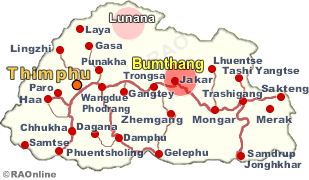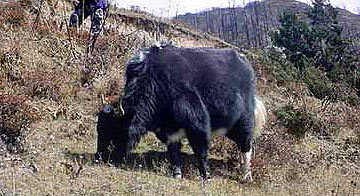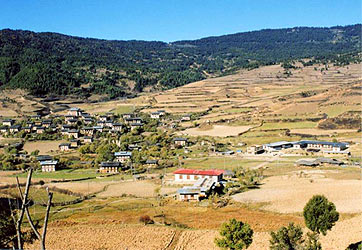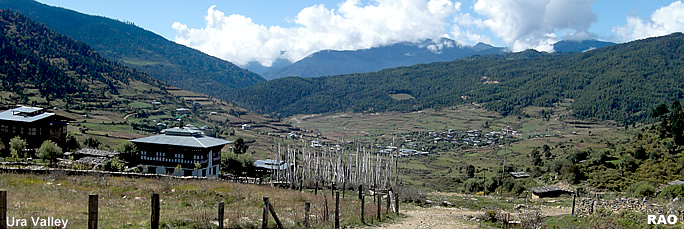 |
Bhutan's
Economy: Yak Farming |
 |
Bhutan's
Economy |
|
|
 |
|
Bumthang:
Yaklha - An integral part of Urap's culture |
 |
Although
yak herders in the country may be decreasing, the age-old tradition of
appeasing the yak deity (yak lha) is still widely practiced by yak
herders in Ura, Bumthang.
According
to herders, the practice has always been an integral part of their society.
In
the seventh month of the Bhutanese calendar, the yak herders and their
family, led by the local priest (lhapon), move from their village
to their cattle-shed in the forest the day before the ceremony. |
At
the cattle shed the lha-poen readies a make-shift altar and prepares torma
(ritual cakes) while the yak herders and their family members spend
the whole night preparing a feast offering of fruits, dairy and other products
derived from yaks.
 |
| The
three-day ceremony starts at dawn with a lhabsang (purification) ceremony. The lha poen erects a prayer flag made from juniper and a three-pronged
pole to hold the torma (lha shing) near the cowshed and food offerings
are placed at the base of the prayer flag.
The
best female and male yak from the herd is decorated with colourfully dyed
yak hair and tied near the lha shing. |
|
The lha
poen then touch the heads of the yaks with yak hair knitted to resemble
a skull and recites prayers accompanied with cymbals and drums.
The
yak herders, their family and guests sit around the yaks while the prayer
is in progress. After the prayer the yak herders prostrate three times
and circumambulate the yaks and pray for a bountiful yield from the yaks.
Milk is then sprayed among the crowd and the yaks and then given to the
people as thrichu (nectar).
The
lha poen concludes his prayers in about an hour after which ara is served
to all at the ceremony.
This
is followed by a feast at the cowshed. However, unlike any other Bhutanese
feasts, there are no meat items since the practice of Boen-kar (a part
of Bonism) does not encourage consumption of meat.
The lha-poen continues his prayer for the next two days which is always concluded with
a tse-ku-yang-ku (prayer for long life and prosperity).
A
61-year old yak herder, Tshewang Dargay from Ura, believes that the practice
of (yak lha was prevalent before the advent of Buddhism in the country).
 |
Ura Valley |
| The
three-day ceremony starts at dawn with a lhabsang (purification) ceremony. The lha poen erects a prayer flag made from juniper and a three-pronged
pole to hold the torma (lha shing) near the cowshed and food offerings
are placed at the base of the prayer flag.
The
best female and male yak from the herd is decorated with colourfully dyed
yak hair and tied near the lha shing. |
|
The lha
poen then touch the heads of the yaks with yak hair knitted to resemble
a skull and recites prayers accompanied with cymbals and drums.
"Before Buddhism,
Bonism with its two sects of Bonkar and Bon-nag, was popular among
the people," he said. The people of Ura appeased the Bonkar deity Jo Tenpai
Sherub as their nor-lha (cattle god).
According
to Dargay, the yak lha ceremony was observed with much funfare in the past.
"We used to celebrate for weeks at a stretch but now that most of the people
have left the village the ceremony is observed only for three days," he
said.
Most Uraps also feel that the number of yaks have declined over the years. Most yak
herders have given up their nomadic traditions to a more settled life.
This
year the yak lha was observed in September at Ura Khandopang where the
majority of the villager's yaks are kept.
According
to the Ura Lower Secondary School Head Teacher, Wangchuk, who participated
in their year's celebration, the yak lha ceremony was a very unique practice.
"It
should be preserved and promoted so that the younger generation know that
such kind of ceremonies are prevalent in the country," he said.
According
to Dargay, the ceremony is held to bring good fortune to the people, and
good health to the animals and keep them safe from the predators.
Since
the ceremony is considered as a very important occasion for the local community,
local schools and offices are closed for the entire three-day ceremony.
| Contributed
by
Chencho Wangdi, KUENSEL, Bhutan's National Newspaper, 2009 |
 |
|
more
information
|

|
|





